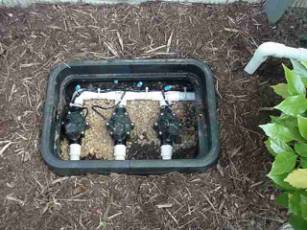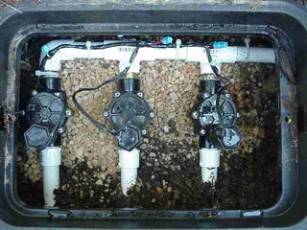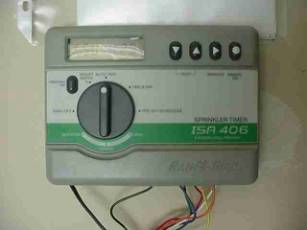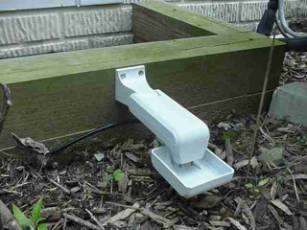Irrigation Control System
This is a simple irrigation control system that was built as a weekend project for less than $200 in parts. The plumbing is constructed of ¾ inch PVC tubing connected to inline solenoid valves made by Rainbird. The threaded ends of the PVC are fitted with brass pipe-to-hose fittings, so ordinary garden hoses can be attached at the outflow end of each solenoid valve. The controller-timer is located in the garage, and can control six independent valves under a variety of programmable settings. There is an automatic rain shut-off so the irrigation system will not operate when there has been a significant amount of precipitation.
Plumbing
This design is built around two identical three-valve manifolds. I have one manifold connected to the hose bib at the back of the house, and one connected to the hose bib at the front. The hose bib connections are made with brass quick-connect couplings so they can be easily disconnected in winter. The hose bib quick-connect is visible in the upper right corner of each of these pictures, where the PVC elbow emerges from the ground. The manifolds are placed in commercial-grade irrigation control boxes with removable lids.
The manifolds can be buried just about anywhere – there is no need for them to be near the hose bibs. However, if the manifold or any portion of the hose connection is above the level of the hose bibs, you must install an anti-siphon valve near the hose bib. This is to stop the backflow from the irrigation system from returning into the house and mixing with the drinking water.

Electrical
Each solenoid valve has two control wires. They are designed to be operated by a 24-volt sprinkler controller. The controller-timer I used is the six-valve Rainbird model ISA-406. It must be mounted indoors (I placed mine in the garage). The controller is connected to the solenoid valves by a length of low-voltage seven-conductor sprinkler control wire, which is designed to be buried in the ground with no conduit. The wire can be hundreds of feet long. The controller is plugged into to a wall outlet via a small transformer. It has a nine-volt battery which allows the unit to retain its programming when power is interrupted.Programming the unit is a fairly tedious process and the controls are not intuitive. It has two programs, A and B, which run simultaneously. Each program turns on the valves in sequential order (1 through 6). Each valve opens for a specified length of time, which can vary from zero to two hours, then it closes and the next valve in sequence opens. A valve can be disabled in a program by setting its time to zero. Each program is set to go off at a preset time of day, and can be set to run every day, every other day, or so on, up to once a week.

Automatic Rain Shut-Off
The system has an automatic rain shut-off, the Rain Check, also made by Rainbird. This simple device has a little water-collection tray with two metal probes (barely visible emerging from the downward-facing tube). When the water in the tray gets deep enough, it shorts the two probes and interrupts the operation of the irrigation system until the water evaporates. The probes are retractable within a certain range of depths so the sensitivity of the shut-off can be adjusted to varying amounts of precipitation.